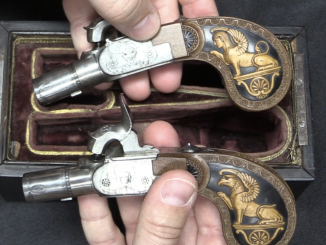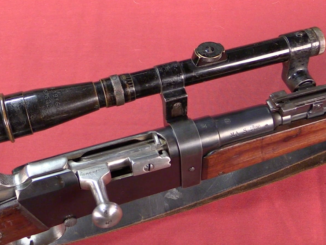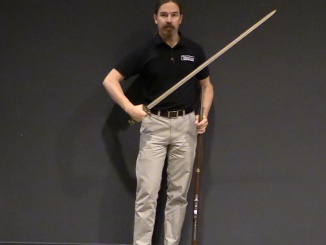Gevarm was the gun-making subsidiary of Gevelot, a long-standing French ammunition manufacturer. In 1956 they brought a simple new submachine gun to market. It was chambered for 9mm Parabellum, with a simple blowback action. The construction was very basic, a combination of a tube receiver, stamped and flat components. There was two versions available; the D3 with a collapsing wire stock and the D4 with a fixed wooden stock (our example in today’s video is a D4).
The French Army tested the gun and found it generally good (although they didn’t like the notch sights). The Army had already adopted the MAT-49 and was happy with it, and so a military adoption had never been likely. Instead, Gevarm marketed the gun to other security organizations in France and to export sales. They did make some contracts, and produced 3-4 thousand of the guns. The French CRS and Paris Police both purchased some, along with some Middle Eastern exports. Given the low manufacturing cost, the project was not a glowing success, but not a failure either.
Many thanks to the IRCGN (Institut de Recherche Criminelle de la Gendarmerie Nationale) for allowing me access to film this rare SMG for you!
0:00 Introduction
0:27 History and Impact of Gevarm, the French Arms Manufacturer
1:39 Detailed Examination of Gevarm D3 and D4 Submachine Guns
3:45 Overview of Gun Features: Sights and Sling Attachments
4:18 Disassembly and Reassembly of the Gevarm D4
7:27 In-depth Look at the Fire Control Group and Receiver
9:20 Testing and Adoption of the Gevarm D4
10:36 Sales and Usage of the Gevarm D4
11:21 Conclusion and Thanks to the IRCGN




I like the idea of someone looking at a MAT 49 and thinking “that’s a bit too complicated”.
It seems like a well made gun. I was impressed by how neatly the magazine grip had been welded to the receiver.
The only time I had ever seen one of these before now was in a 1970s TV show called “Return of the Saint”, where our hero battled evil French bandits armed with Gevarm D3s and MP40s. It seems like a decent gun and deserved to do better.
How radical was the M16, or AR-15/10 if you prefer, with its straight line stock with no drop? That seems to be holy writ these days, but until that everybody seemed to have the buttplate dropping down like a handsbreadth from the line of recoil. Am I wrong?
Straight-line no-drop was featured at Solothurn 31.M Golyószóró of interbellum period, see 1st photo from top http://hungariae.com/Soloth.htm
The French MAS 38 SMG in 7.65 x 20mm has such a setup. It’s easy to miss seeing it because the stock (which houses the recoil spring as on the AR-15 family) is in line with the bolt’s travel, which is at an angle to the bore line.
https://www.forgottenweapons.com/french-mas-38-smg/
clear ether
eon
There’s a good chance that the plug on the rear end of the recoil spring, can be assembled in the bolt as well
That was a patented feature of the Gevarm .22rf rifles.
It allows some adjustment of the weight of the bolt to achieve operation with different loadings of ammunition, or in varying temperatures as well.
I don’t know whether Gevarm attempted to sell the 9mm into Canada, apparently the .22 sporting rifles were sold in Quebec.
“Gevarm D4: An Economical MAT-49 Alternative(…)”
Interestingly, despite being that, it featured single-fire mode, as opposed to standard MAT-49.
I can remember reading one of Ian Hogg’s books where he had some advice for would be submachine gun designers. He was talking to an international arms dealer and the subject of new SMG designs came up. With a rather pained look on his face, the dealer replied, “When someone comes to me trying to sell, or worse, to bankroll the production of a new gun, I take them to my warehouse and point out the crates of unsold surplus SMG’s I have and ask them what their design does that these don’t and if their price is less than what I can get from the government.”
I do agree that D4 was introduced in hard times for new sub-machine guns, but regarding
what their design does that these don’t
I want to point that as its’ selector zero-shots setting prevents moving parts in going to rear position it should be provide enhanced drop safety whilst compared to some WW2-era sub-machine guns.